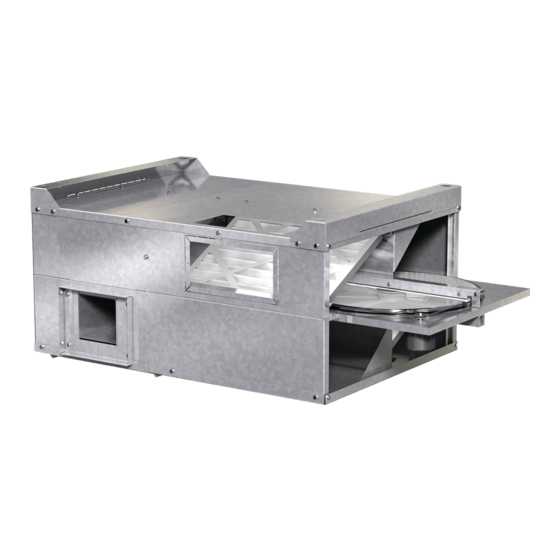Table of Contents
Advertisement
®
Installation, Operation and Maintenance Manual
Please read and save these instructions for future reference. Read carefully before attempting to assemble,
install, operate or maintain the product described. Protect yourself and others by observing all safety
information. Failure to comply with instructions could result in personal injury and/or property damage!
Model MiniVent-450 & 750
General Safety Information
Only qualified personnel should install this system.
Personnel should have a clear understanding of these
instructions and should be aware of general safety
precautions. Improper installation can result in electric
shock, possible injury due to coming in contact with
moving parts, as well as other potential hazards.
Other considerations may be required if high winds
or seismic activity are present. If more information
is needed, contact a licensed professional engineer
before moving forward.
DANGER
Always disconnect power before working on or near
this equipment. Lock and tag the disconnect switch
or breaker to prevent accidental power up.
CAUTION
When servicing the unit, the internal components
may be hot enough to cause pain or injury. Allow
time for cooling before servicing.
CAUTION
Precaution should be taken in explosive
atmospheres.
®
Energy recovery wheels are certified by the AHRI Air-to-Air Energy Recovery Ventilation Equipment
Certification Program in accordance with AHRI Standard 1060. Actual performance in packaged
equipment may vary.
Certified Ratings are available in the Certified Product Directory at www.ahridirectory.org
Energy Recovery Ventilators
1. Follow all local electrical and safety codes, as well
as the National Electrical Code (NEC), the National
Fire Protection Agency (NFPA), where applicable.
Follow the Canadian Electric Code (CEC) in
Canada.
2. All moving parts must be free to rotate without
striking or rubbing any stationary objects.
3. Unit must be securely and adequately grounded.
4. Do not spin fan wheel faster than maximum
cataloged fan RPM. Adjustments to fan speed
significantly affects motor load. If the fan RPM is
changed, the motor current should be checked to
make sure it is not exceeding the motor nameplate
amps.
5. Do not allow the power cable to kink or come in
contact with oil, grease, hot surfaces or chemicals.
Replace cord immediately if damaged.
6. Verify that the power source is compatible with the
equipment.
7. Never open access doors to the unit while it is
running.
Energy Recovery Ventilators • MiniVent
Part #459023
1
Advertisement
Table of Contents

Summarization of Contents
General Safety Information
Safety Precautions Overview
General safety precautions for unit installation and operation.
DANGER: Electrical Disconnection
Critical safety warning: always disconnect power before working on equipment.
CAUTION: Component Temperature
Warning about hot internal components that may cause injury during servicing.
CAUTION: Explosive Atmospheres
Precautionary note regarding safe operation in potentially explosive atmospheres.
Receiving, Handling, and Storage Procedures
Product Receiving and Damage Inspection
Check all items upon delivery, inspect for shipping damage, and notify carrier.
Unpacking and Part Verification
Verify all required parts and quantities received; report any shortages.
Unit Handling and Finish Protection
Guidance on rigging and moving units to prevent scratching or chipping.
Storage Recommendations and Inspection
Precautions for preventing unit deterioration during storage and monthly inspections.
Unit Dimensions, Weights, and Clearances
Unit Dimensions and Weight Specifications
Provides physical dimensions and weight data for MiniVent 450 and 750 models.
Recommended Service Clearances
Minimum clearances required for routine maintenance, filter, and fan access.
Access Panel Locations
Identifies access panel locations for fans, motors, and the energy wheel cassette.
Airflow Configuration and Installation Methods
Intake and Discharge Location Options
Diagrams showing intake and discharge locations, including optional field relocation.
Hang Mounting Installation Procedure
Step-by-step guide for installing the unit using hanging vibration isolators.
Mounting, Ducting, and Vibration Isolation
Base Mounting with Vibration Isolation
Instructions for mounting the unit on a base using base vibration isolators.
Duct Connection Best Practices
Guidance on proper fan-to-duct connections for optimal airflow and noise reduction.
Recommended Discharge Duct Sizing
Table of recommended discharge duct sizes and lengths for MiniVent units.
Electrical Connections and Wiring Schematics
Electrical Safety and Connection Guidelines
Electrical connection guidelines, safety codes, and high voltage warnings.
Wiring Schematics and Sequence
Overview of wiring diagrams and the sequence for unit wiring.
Fan Control and Frost Protection Wiring
Variable Speed Fan Control Wiring
Wiring diagram for implementing independent variable speed fan control.
Timed Exhaust Frost Control Wiring
Wiring diagram for timed exhaust frost control using a temperature controller.
Frost Control with Speed Controllers Wiring
Wiring diagram for frost control combined with variable speed fan control.
System Start-Up Procedures and Checks
Startup Warnings and Preparations
Warnings about operating without filters and preparing for startup.
General and Voltage Checks
Perform general checks for fasteners, dampers, and verify supply voltage.
Component Performance Checks
Check blower rotation, air volume, motor amperage, and fan RPM.
Routine Maintenance Procedures
Maintenance Safety and General Schedule
Safety warning for power disconnection and recommendation for annual inspection.
Component Checks and Cleaning
Check fasteners, remove dust/dirt from motors and wheels, maintain filters.
Energy Wheel Access, Removal, and Cleaning
Procedures for accessing, removing, and cleaning the energy recovery wheel.
Energy Wheel Maintenance and Documentation
Energy Wheel Cleaning Frequency and Belt Drive
Guidelines for cleaning frequency and maintenance of the drive belt.
Unit Documentation and Start-Up Records
Forms for recording job details, service information, and field start-up data.
Troubleshooting Common Issues
Unit Operational Issues Troubleshooting
Troubleshoot unit not operating, excessive noise, or intermittent operation.
Airflow and Noise Troubleshooting
Address low airflow, high airflow, and excessive noise issues.
Energy Wheel Operational Troubleshooting
Troubleshoot energy wheel not turning or running issues.
Maintenance Log and Warranty Information
Routine Maintenance Log
Log for recording dates, times, and notes of performed maintenance activities.
Equipment Warranty Details
Details the warranty period for the equipment and the energy recovery wheel.



Need help?
Do you have a question about the MiniVent-750 and is the answer not in the manual?
Questions and answers